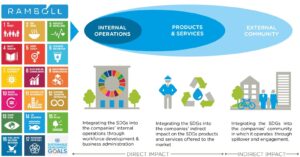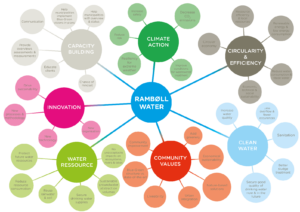Executive Summary
Ramboll and the SDGs
As part of Ramboll’s strategy to become a recognised leader for sustainable solutions, we use the 17 UN SDGs as our yardstick for sustainability. The SDGs, and their 169 underlying targets, are drivers for future investments and define global priorities and aspirations for 2030. Ramboll has focused its efforts on identifying opportunities within the sustainability agenda, demonstrating how the company is already contributing to the 17 global goals and how it can further contribute through our practices. The SDGs provide Ramboll with a strong practical, structured and cross-organisational platform for sustainability. By working with the SDGs, we also enhance internal and external cooperation, and are better placed to develop holistic solutions for our clients, supporting their goals and priorities in line with the SDGs.
Process for integrating the SDGs
Ramboll has conducted an SDG market assessment and analysis inspired by the UN SDG Compass to identify the company’s direct contribution to the SDGs. The mapping exercise consisted of several assessments of our six markets against the 17 SDGs. The process included the involvement of various stakeholders, both externally and internally, and considered different ways of assessing Ramboll’s impact and contribution to the SDGs. Hence, the assessments explored Ramboll’s positive/negative and direct/indirect impact on each of the 169 targets; the relevance of each SDG and its targets to each of our markets (e.g. in terms of market opportunities and current market position); SDG synergies across Ramboll markets (e.g. potential for upscaling positive impacts); as well as current level of identified impacts within each market (e.g. large and/or high revenue service lines vs. niche services).
Our contribution
Many Ramboll markets have a strong specialised focus, delivering solutions to one or two SDGs for example Clean Water and Sanitation (SDG 6), and when examining the entire Ramboll Group, we also identified strong cross-market sustainability themes such as Sustainable Cities & Communities (SDG 11) and Climate Actions (SDG 13). Some SDGs already have a strong market relevance across Ramboll, some provide significant market opportunities and some contribute on a smaller scale with room to grow. Many Ramboll services help mitigate the negative impacts on the SDGs through measures such as environmental impact assessments and for example, by improving water quality through wastewater treatment increasing recycling and safe reuse of water or by strengthening resilience and adaptive capacity to climate related hazards and natural disasters.
Related SDGs:
3 – Ensure healthy lives and promote well-being for all at all ages
6 – Ensure availability and sustainable management of water and sanitation for all
9 – Build resilient infrastructure, promote inclusive and sustainable industrialisation and foster innovation
13 – Take urgent action to combat climate change and its impacts
16 – Promote peaceful and inclusive societies for sustainable development, provide access to justice for all and build effective, accountable and and inclusive institutions at all levels
Background
The initial mapping of the Ramboll Markets and their contributions to meeting the SDGs done at Ramboll Group Level resulted in the overview illustrated in Figure 1 above. To understand, what Ramboll can do in addition to the business as usual to help accelerate attaining the SDGs, a series of workshops was planned to identify the components and necessary actions to increase the sustainability aspects of our work.
Ramboll delivers a wide range of water-related services; from early phase strategic analysis and project scoping to design and implementation of infrastructure solutions within the following four areas:
• Climate Adaptation & Landscape
• Water and Wastewater Treatment
• Water & Wastewater Networks
• Water Resources
The workshop focused on how the Ramboll Water services support ensuring safe water supply, increasing water-use efficiency, proportion of treated wastewater, and integrated water resource management at all levels, as well as address global water and climate challenges by working across the water cycle from water resources and supply, processing and treatment, to sewerage and discharge. The mapping showed, that all Ramboll Water services already contribute positively to sustainable development, but the workshop also identified how the service could go above and beyond in supporting the attainment of the SDGs by operationalising them into the Ramboll practices and how Ramboll could monitor and evaluate their process.
Challenges
The challenge is to ensure, that sustainability is integrated into all levels of the company’s practices (services and operations), as illustrated in figure 2 below, in a structured and systematic way, that allows for monitoring and evaluation. In order to achieve this, a more universal consensus on “sustainability” is necessary. Thus, a workshop sequence was planned and executed in order to identify the sustainability components and actions characterising the internal operations, products and services and in the way the company interacts with the external community. The workshop included identification of key performance indicators (KPIs) to ensure, that the components developed would be concrete and measurable in order for Ramboll to track their process and progress in delivering sustainable solutions.
Results
Through the workshop, internal stakeholders from within Ramboll Water identified seven components (see figure 3) central to the Ramboll Water services to be integrated into the project planning and execution, along with first take on measurable targets to inform monitoring and evaluation of sustainability performance. The components and targets are incorporated into a “sustainability scoreboard” to ensure, that the outcome is operationalised into all three levels of operations.
The scoreboard is currently being refined and the monitoring and evaluation framework was developed for final dissemination during the fall of 2018.
How to replicate?
The process developed by Ramboll is highly replicable in other organisations, companies, departments, etc. In short:
Step 1 – get a contextual consensus as to how your entity understands and wishes to work with and implement sustainability
Step 2 – identify the components (3-10) and associated measurable targets to focus the sustainability implementation on
Step 3 – develop an action plan to implement the components and build a framework for continued monitoring and evaluation
This case study is the result of the SDG Taskforce work on collecting case studies about how IWA (corporate) members are catalysing action to achieve the SDGs. Click here to connect to the SDG Taskforce.




